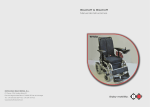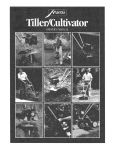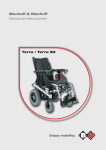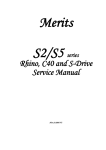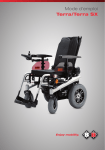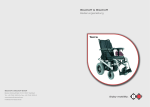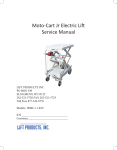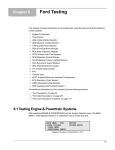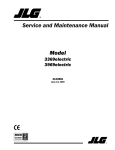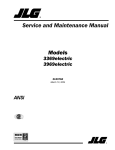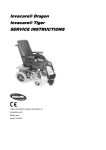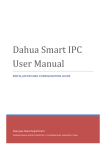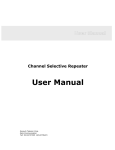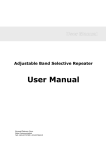Download S142/S145 Service Manual
Transcript
Merits S1/S3 series Rhino Service Manual Nov.9.2006 V1 S1/S3 series-Rhino Service manual Page Introduction-------------------------------------------------------------------1 1.Service guide---------------------------------------------------------------1 2.Battery-----------------------------------------------------------------------1 2.1 When to replace the batteries-----------------------------------------1 2.2 To remove the batteries------------------------------------------------1 2.3 To install the batteries--------------------------------------------------2 2.4 Check battery charge---------------------------------------------------2 3. Motor, brush and Parking brake-----------------------------------------2 3.1 Motor---------------------------------------------------------------------2 3.2 Brushes-------------------------------------------------------------------4 3.3 Parking Brake-----------------------------------------------------------4 4. Tiller Instrument---------------------------------------------------------10 4.1 Tiller disassembly/assembly procedure----------------------------11 4.2 Throttle Potentiometer-----------------------------------------------13 4.3 Dash board ------------------------------------------------------------15 4.3.1 Analog Dash board------------------------------------------------15 4.3.2 Digital Dash board------------------------------------------------16 5. Examples of Electrical illustrated parts breakdown-----------------17 5.1 S1-series--------------------------------------------------------------17 5.2 S3-series--------------------------------------------------------------18 6. Scooter troubleshooting-------------------------------------------------19 (Typical problems and solution) 7. Controller-----------------------------------------------------------------22 7.1 Rhino connection and wiring---------------------------------------22 7.2 Programming Rhino--------------------------------------------------24 7.2.1 Setup Menu-------------------------------------------------------27 7.2.2 Option Menu-----------------------------------------------------32 7.2.3 Common programming errors---------------------------------34 7.3 Rhino Diagnostics and fault finding-------------------------------35 7.3.1 Diagnose fault---------------------------------------------------35 7.3.2 flash code--------------------------------------------------------38 8.Charger--------------------------------------------------------------------39 8.1 Operation instruction------------------------------------------------39 8.2 LED indication-------------------------------------------------------40 8.3 Troubleshooting------------------------------------------------------40 9. Scooter diagnostic flow chart------------------------------------------42 Introduction The purpose of this manual is to provide dealers and/or distributors with the product information and instructions that are required for servicing the S1/S3 series electrical scooter. 1 Service Guide n n n n n n n n Batteries Motors, Brush and brake Tiller instrument Electrical illustrated parts breakdown Troubleshooting Dynamic Rhino controller Charger Scooter diagnostic flow chart WARNING Before performing any maintenance or service, turn the power off. NEVER allow tools and/or battery cable(s) to contact BOTH the battery terminal(s) or the post(s) at the same time. An electrical short may occur resulting in serious personal injury and/or damage. It is strongly recommended that battery installation and/or replacement should be done only by a qualified technician. 2 Batteries n Battery type: Lead-acid *2 pieces 2.1 When to replace the batteries The batteries may have to be replaced should one of the following conditions occurs: n The scooter’s driving distance decreases significantly. n Incomplete charge. n The Charging cycle becomes significantly longer or shorter than before. 2.2 To Remove the Batteries 1. Remove the seat and shroud and unplug rear lights connector. 1 2. Disconnect the wiring harness from the batteries by removing the screws. 3. Remove the batteries from the scooter base. 2.3 To install the Batteries 1. Install two new batteries into the power chair base. 2. Connect the wiring harness to the batteries. Refer to“Electrical illustrated parts breakdown” diagram. 3. Confirm the battery supply voltage. (the battery voltage to the controller should be at least 25VDC) 4. Plug rear lights connector and cover the shroud and install the seat. 2.4 Checking Battery Charge: 1. Connect the voltmeter negative probe to controller power-. 2. Connect the voltmeter positive probe to controller power+. 3. The voltmeter should measure 23-27 volts (i.e. Battery Voltage). 4. If the voltage is negative, check for correct battery wiring polarity. Ensure that batteries are connected correctly. 5. If the voltage reading is zero, check for wiring open circuits or battery wiring polarity. 6. Charge the batteries completely before driving. 3 Motor, brush and parking Brake 3.1 Motor: The 24V motors are specifically designed for use on electrical scooter. The motors incorporate a metal-cased parking brake. The parking brake assembly and brushes are protected by a metal cover. The motor frame is integral with the cast aluminum gearbox housing that forms a strong and compact unit. An easy-to-operate brake lever engages/releases the magnetic brake for manual pushing of the scooter. Connections and Wiring 1. Each motor has four wires of two different sizes that require connection. Note that the red and blue(or black) wire connections will affect the motor orientation. 2. Upon completing all wirings the loom must be fastened to the frame to minimize strain on the connections. 2 3. Lift the wheels before making the battery connection and check if the drive system functions correctly. 4. Ensure that the scooter’s power system is equipped with a circuit breaker or fuses. Testing Check the motors and control system when the installation is completed. Note the following points: The circuit breaker or fuses must be included in the power circuitry. n Lift the wheels off the ground; n Do not arc cables to check for power. n Use a multimeter to check the voltage. Operation of Brake lever When it is desired to manually push the scooter, the brake lever is easily released. Simply push/pull the lever on the magnetic brake. Labels are available for indicating the status of the brake lever. Maintenance and Servicing The motor is a low-maintenance-required motor and except for periodic checkup, requires no further maintenance under normal conditions. The batteries should be disconnected during any maintenance procedure and in fact their complete removal from the scooter may help access. n Check system regularly. n Check for loose, damaged or corroded connectors and terminals. n Replace damaged cabling. n Check motor mountings for tightness. n Clean motor and control system components with a damp cloth. n The cover may be removed to check the brush length. n Check for oil or grease leaks around the seals, output shaft, and brake lever. n Check motor for increased backlash or play, excessive noise or other indications of the gear wear-out. 3 Warning: Do not use the motor if there is any indication of damage or if abnormities such as: damage to the case, grease leakage, abnormal response as well as excessive backlash or play, noise, heat, smoke and/or arcing are present. Ensure that the motor is securely fastened to the transaxle and the wheel securely fastened to the transaxle. 3.2 Motor Brushes Each motor contains two or four carbon brushes which may require replacement after operating the scooter a long period of time. Brush replacement is a simple operation: n Disconnect the motor. n Remove the end cover to allow access. n Remove the brush. n Check the commutator for excessive wear or unusual burns or erosion marks. n Reverse the above processes to install the new brush, ensuring that the brush is still able to slide in the brush guide. n Ensure the springs seat properly on the brush and the brush wire is placed properly. Note: Ensure correct insulation between motor case and motor wires (refer ISO 7176-14). n Always replace all the brushes in both motors at the same time. n Run brushes in for several hours in the forward direction. Ensure that the parking brake is released when operating the motor. (This reduces brush bounce which causes arcing and in turn generates RFI and audible noise.) 3.3 Parking Brake: Poor parking brake holding ability indicates the need for replacing the parking brake assembly. n Disconnect the motor. n Remove the cover to allow access. n Cut/solder the wires of the parking brake. Avoid excess strain 4 on the wires. n Remove the screws that hold the parking brake assembly together. n Reverse the process to install the new parking brake assembly. n Check the armature which must rotate freely with the parking brake disengaged. Parking brake replacing procedure: 5 6 7 8 9 4. Tiller Instrument In case tiller instruments are to be checked or replaced, tiller shroud must be dismantled first to allow access. 10 4.1Tiller disassembly/assembly procedure; 11 12 B: Tiller assembly procedure: You can just backward the disassembly procedure to assemble the tiller. Remember to tighten every screw and make sure every connector is plugged firmly. 4.2 Throttle Potentiometer( POT): In some cases, scooter can not move results from POT problems. There are three typical POT problems. 1. Speed POT wire broken or short-circuited(Rhino flash code 7) 13 Check if wires shorted or connector loose. 2. Speed POT out of range(Rhino flash code 7) Measure the resistance between “1”and “3”of the potentiometer. It must be 5KΩ±10%. If not, Replace the potentiometer. 3.Speed POT not in neutral position(Rhino flash code 6) Measure the resistance between “1”and “2”of the potentiometer. It must be 2.5KΩ±10%. If not, recalibrate the neutral position. Measure the resistance between “2”and “3”of the potentiometer. It must be 2.5KΩ±10%. If not, recalibrate the neutral position. 1 2 3 Follow the wire color allocation--as picture below-- to solder the wire to the potentiometer. 14 4.3 Dash board PCB Dash board handles all accessories of the scooter, like lighting system, buzzer, switches, battery gauge, charging inlet, keypad, speed adjust, throttle potentiometer. Sometimes the accessory problems may turn out to be caused by dash board PCB. Make sure all wires are not loose and all connector are connected firmly. If everything is fine but the problem still remains, replace the dash board PCB and test. 4.3.1 Analog dash board PCB Following picture shows function of each connector on analog dashboard PCB. 13 1:Main cable connector 2:Key switch connector 3:Speed POT. Connector 4:Charger connector 5:Status LED connector 6:Hazard switch connector 7:Direction switch connector 8:Head light switch connector 9:Horn switch connector 10:Reduce speed switch connector 11:Turning reduce speed sensor connector 12:Lighting system connector 13. Speed adjust VR. Connector 15 4.3.2 Digital dash board PCB 2 4 1 5 6 7 8 3 1:Main cable connector 2:Key switch connector 3:Speed POT. Connector 4:Charger connector 5: Lighting system connector 6:Key pad connector 7: Turning reduce speed sensor connector 8: Reduce speed switch connector 16 5 Examples of electrical illustrated parts breakdown 5.1 S1-series scooter 17 5.2 S3-series scooter 18 6. Scooter troubleshooting ---Typical problems and solutions Problem Possible Causes Solution Scooter does not run (Scooter not moving and lights do not work using battery, but lights do work when you plug the charger into the scooter and also plug the charger into the wall outlet) Undercharged battery Charge the battery. A new battery should have been charged for at least 12 hours before using the vehicle for the first time and up to 8 hours after each subsequent use. Check all connectors. Make sure the charger connector is tightly plugged into the charging inlet, and that the charger is plugged into the wall. Make sure power flow to the wall outlet is on. Charger is not working You may check to see if your charger is working by using a volt meter Burned out fuse Replace the fuse. Scooter does not run (Scooter not moving and lights do work using battery,) Controller diagnostic (flashcode) Follow controller section(Chapter 7.3.2) to see flashcode meanings and Solutions. Status LED fail If status LED is dimly light or not working, replace with new one. Scooter not moving and all lights do not work with only batteries. Burned out fuse Replace the fuse Scooter was running but suddenly stopped Controller trip Loose Check if wires/connections are tight. wire/Connection The controller will automatically shut off the power if the motor is overloaded. An excessive overload, such as too heavy a rider or too steep a hill, could cause the controller to overheat. If the scooter suddenly stops running, wait a few seconds and let the controller cool down. Tripped circuit breaker or burned out fuse Check all wires and connectors to make sure they are tight. The circuit breaker or fuse will automatically shut off the power if overload or short-circuit happens. If the scooter suddenly stops running, push the breaker to reset the circuit 19 or replace the fuse. Correct the conditions that caused the breaker/fuse to trip and avoid repeatedly tripping the breaker. Short run time (less than usual per charge) Undercharged battery Charge the battery. A new battery should have been charged for at least 12 hours before using the scooter for the first time and up to 8 hours after each subsequent use. Check all wires and connectors. Make sure the charger plug is tightly plugged into the charging socket, and that the charger is plugged into the wall. Make sure power flow to the wall outlet is on. Scooter runs sluggishly Battery is old and will not accept full charge Even with proper care, a rechargeable battery does not last forever. Battery life depends on scooter use and conditions. Replace the battery if necessary. Hand brake is not adjusted properly Adjust the handbrake neutral position to reduce the friction between brake disk and brake lining when brake is in neutral position. Tires are not Make sure the tires have sufficient air but this usually is not properly inflated the problem. The tires are inflated when shipped, but they will lose some pressure between the point of manufacturing and delivery. Check tire pressure and properly inflate the tires. Scooter is overloaded Make sure you do not overload the scooter by carrying too much weight, going up a hill or towing objects behind the scooter. If the scooter is overloaded, the controller may go into protection mode and even shut off power to the motor. Correct the driving conditions that caused the overload, wait a few seconds, and then let the controller to recovery. Avoid repeatedly overloading the scooter. Hand brake is not adjusted properly Adjust the handbrake neutral position to reduce the friction between brake disk and brake lining when brake is in neutral position. Battery problem Battery needs to be recharged. If after full charging the 20 batteries, the scooter still runs sluggishly. Replace the batteries. Sometimes, it may be too cold to operate the scooter. The battery does not output much current at low temperatures (below 5 degree C). It is too cold to operate. Sometimes the scooter doesn’t run, but other times it does Loose wires or connectors Check all wires and all connectors to make sure they are tight. Switch bad Check ON/OFF switch to make sure it is working properly. Charger gets warm during use Normal response to charger use No action required. This is normal for chargers and is no cause for concern. If the charger does not get warm during use, it does not mean that it is not working properly. Scooter can not stop on a slope Magnetic brake are not working properly Possibly the brake lining is worn out. Replace the magnetic brake. Scooter takes off - will not stop Throttle potentiometer problem If the scooter is moving when you release the throttle , you will need to adjust the potentiometer neutral position or replace the throttle potentiometer. After charging for 8 hours, the scooter battery gauge does not show a full charge Charger Charger may be bad. Replace charger. This is the most common. Charger connection Charger connection on scooter is bad- usually a wire on the back of the charger socket is loose. Battery Batteries are bad. Replace new ones Loose wire/connection Check if wire/connection is tight. Battery gauge Battery gauge is bad. Replace new ones. Bulb Check /Replace light bulb. All lights work and scooter can move but the battery gauge does not work. Light is not working. Loose Check if wire/connection is tight. wire/Connection Switch Check switch function, If bad, replace new one. Dashboard PCB If light bulb , wire connection and switch are all OK, Replace dashboard PCB. 21 7.Controller The Rhino Controller The RHINO scooter controllers includes: •70A model (DS72K) for small-to-medium-size scooters •110A model (DS112K) for medium-to-large-size scooters •160A model (DS162K) for large scooters 7.1 RHINO Connections and Wiring RHINO connections are located along the front of the case. The illustration below indicates the different connectors and gives a section reference for specific installation instructions. When all wiring has been completed, it must be securely fastened to the scooter frame to ensure there is no strain on the connectors or any chance of snagging. Before making any connections to RHINO, disable the scooter by one of the following means to prevent accidental movement or arcing: 1) place the battery circuit breaker in the open position, or 2) disconnect the batteries 22 Typical Wiring Diagram for RHINO DS52K, DS72K, DS112K 23 Typical Wiring Diagram for RHINO DS162K 7.2 Programming RHINO Using a hand-held programmer DZ-DS-PM, the controller settings can be modified if desired. DZ-DS-PM (Manufacturer Version) Programmer Tree 24 * Parameters available to DZ-DS-PD ** DS162K Only RHINO Programming Warning : Only qualified personnel should make alterations to RHINO programming. Incorrect or inappropriate programming of RHINO can put the scooter into a dangerous state. Manufacturer accepts no responsibility or liability for accidents caused by incorrect programming. On completion of programming, we recommend a drive test be carried out to ensure performance is as desired. Note :If the scooter is turned off during programming, any changed settings 25 are not saved and RHINO defaults back to the previously programmed settings. 26 Programmable Settings The following settings can be modified so that a scooter can meet user’s needs. Not all of these settings are available from the Scooter Programmer. 7.2.1 Setup Menu These settings customize the scooter to user preferences and/or environment. 27 28 29 30 31 7.2.2 Options Menu These settings are adjustable using a hand held programmer. Settings via the programmer can be either ON or OFF. 32 33 7.2.3 Common Programming Errors Sometimes after changing certain parameters, in particular, when customizing the Motor Reverse and Pot Reverse settings, the scooter might not drive in the way that was intended. Following is a matrix of Motor Reverse and Pot Reverse 34 settings and the impact they have on the motion of the scooter. 7.3 RHINO Diagnostics & Fault Finding RHINO provides diagnostics information to assist technicians with diagnosing and correcting faults within the scooter system. A fault in the scooter will cause the RHINO Status Light to flash separated by a pause. The number of flashes in each burst, also referred to as the flash code, indicates the nature of the fault. Depending on the severity of the fault and its impact on user safety, RHINO will react differently. It can: • Display the flash code as a warning but allow normal driving and operation. • Display the flash code as a warning but allow limited driving and operation. • Display the flash code, stop the scooter and prevent driving until the scooter has been turned off and then back on again. Descriptions of what each flash code means can be obtained by plugging in the RHINO programmer. Detailed descriptions of what each flash code means and the probable cause and remedy for each are described in flash code table . 7.3.1 Diagnosing RHINO Faults Use the following troubleshooting guide if the scooter fails to operate. The guide will help identify whether the fault exists within RHINO or another part of the scooter system. Required equipment: Voltmeter Note: Elevate the drive wheels before carrying out the following tests. Turn the key switch on before beginning any diagnostics. The voltages shown are nominal values. Warning: Testing should only be carried out by qualified service personnel. 35 36 37 7.3.2 RHINO Flashcodes 38 8.CHARGER(HP8204B) 8.1 Operating Instruction (1) To select the input voltage (115V/230V) and make a correct option by 115/230V option switch. 39 (2) To assure the charged batteries are lead acid batteries. (3) To keep the AC power switch in "off " position before the charge circuitry and battery have been connected completely. (4) To check if the output end of charger corresponds with the positive/negative pole of battery. (5) After the above sequences have been finished, please turn on the AC power switch to "I" and the fan will begin to run. When LED turns red/yellow, it means the charger has been under normal charging condition (If the abnormal phenomena occurs, please turn off the charger immediately and check the 1~4 sequences repeatedly, then turn on the charger again.) (6) When LED turns to red/green, that means the batteries have been finished for complete charge. (7) Under the condition of yellow/green LED. It may have a temporary alternating phenomenon around 1~60 seconds during switching, please note this is a normal feature. 8.2. LED Indication LED (POWER)-RED LIGHT ON: Power On LED (CHARGE)-LIGHT OFF: Battery Disconnect YELLOW LIGHT ON: Charging GREEN LIGHT ON: Full-Charged 8.3 Troubles Shooting (1) When the power switch sites "on" but no LED light up: To check the connection of power cord To check the connection of socket. To check if the fuse is under normal condition. (2) When the power switch sites "on" but red/yellow LED do not light up completely and the fan does not run: To check if the output wire occurs short circuit (3) When the power switch sites "on", red LED light up, but green LED flashes and no charging action: To check if the output fuse has severed To check the connection between output connector and the battery To check if having made a correct connection for the battery polarity. To check the battery is connected completely. (4) If the fuse is burned-out as soon as the power switch has been turned on and no effect at all: After having been replaced with another new/same fuse. Please do not dismantle 40 the charger or replace with other larger fuse by yourself. (5) The charge time continues for a long duration(abnormal): To check if the battery has been broken down or aged (6) The yellow/green LED have flashed over 40 minutes during charging: To check if the battery is broken down (7) The battery heats(abnormal): To stop charging and check if there are troubles occurred on the charger Caution (1) If there is a ground wire for the power cord of charger, for safety purpose, please be sure to make a good ground connection job. (2) To make sure the DC output corresponding with the battery which will be charged and the voltage value, otherwise, it may cause battery explosion and hurt someone. (3) To keep the power on/off switch in "o" position before the charge circuitry and battery have been connected completely. (4) Do not expose the charger to the rain, water or store it at humid place. 41 9. Diagnostic flow Chart 42 43 44 45 46 47 48 49 50 51 52 53 54 55

























































